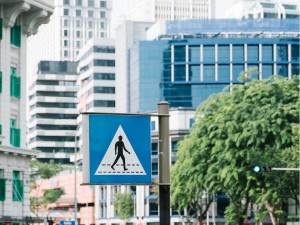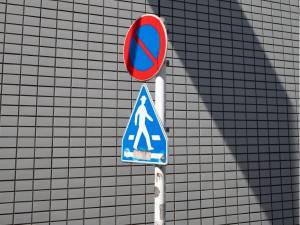
JKR road signage specification is essential for safety and efficient traffic management. It provides vital information to drivers, reducing accident risk and alerting them to hazards and changes in road conditions.
Clear signage improves traffic flow, guides through complex intersections, informs speed limits, and reduces congestion, enhancing overall travel efficiency.
General Principles of Traffic Signs by JKR Malaysia
Kerajaan Malaysia Guide Signs Design and Application guidelines are regularly updated to incorporate new technologies, ensuring safer roads, and improved traffic management for the benefit of road users, road and traffic authorities, and manufacturers of traffic signs.
Visibility and Legibility
A traffic sign should be easily visible and able to be read without diverting the sight through too great an angle to ensure safety. Use large, clear fonts, high-contrast colours, and strategic placement. High-contrast colours like black on white or yellow improve visibility.
Clear, sans-serif fonts and reflective materials enhance legibility, especially at night or in poor light. This ensures drivers can quickly and easily understand the information.
Uniformity and Consistency
Standardised signs are essential for road safety as they allow for quick, universal recognition, preventing confusion and enhancing safety.
Consistency in shapes, colours, and symbols across regions, as per JKR guidelines, ensures drivers understand and respond correctly to signs like the octagonal red stop sign. Uniform signage makes roads safer and navigation easier.
Placement and Orientation
Effective traffic signs rely on strategic placement and correct orientation. Signs must be positioned to provide timely information, regulatory signs at control points, warning signs before hazards, and informational signs for guidance.
Proper orientation ensures signs face oncoming traffic for maximum visibility and comprehension.
Size Requirements for JKR Road Signs
JKR Malaysia establishes size standards for signs to ensure readability and visibility. Sign size is determined by the height of the lettering, with larger letters needed for highways due to higher speeds. Factors like roadside obstructions may also influence sign size.
Dimensions
Regulatory Signs give notice of traffic laws, and Warning Signs alert drivers of hazards ahead. They are at least 600 mm × 600 mm, larger signs are used on high-speed roads for better visibility.
Guide Signs and Informational Signs provide important guidance and information. Text size varies by location, 150 mm high on major routes and 100 mm high on city and rural streets.
Height and Placement
Regulatory and Warning Signs are typically placed 1.5 to 2.0 metres above the ground, while Guide Signs and Informational Signs are placed 2.0 to 2.5 metres high for better long-distance visibility.
Signs are positioned 1 to 2 metres from the roadway edge to ensure visibility with minimal obstruction.
Lettering Size on Street Signs
Street signs use specific lettering sizes for optimal visibility, at least 100 mm high on low-speed roads and up to 150 mm high on major and high-speed roads, ensuring readability and enhancing driver safety.
Clear sans-serif fonts improve legibility of street signs, enhancing quick recognition and understanding. Consistent font styles reduce confusion and ensure effective traffic management. JKR’s recommended fonts promote uniformity in road signage.

Material of Road Signs
JKR Malaysia specifies sign materials to ensure durability, functionality, and visibility. Materials should be reflective for enhanced visibility at night and in low light conditions.
Common Materials Used
- Aluminium signs are popular for being lightweight, corrosion-resistant, and easy to fabricate, making them durable and ideal for outdoor use.
- Steel signs are strong and durable, but heavier than aluminium and may require extra coatings to prevent rust.
Durability and Weather Resistance
Road signs must withstand harsh weather conditions to ensure they remain visible. Durable materials such as steel or aluminium composite material are often used, and these are typically enhanced with additional protective coatings.
These coatings reduce weather damage, ensuring the signage lasts longer and remains reliable. Regular maintenance is also essential to keep signs in optimal condition and effectively guide drivers.
Reflective Materials for JKR Road Signs
JKR Malaysia uses high-quality retroreflective materials to enhance the visibility of road signs, especially at night or in low light conditions. The reflective material’s quality and type can affect a sign’s overall effectiveness.
- High-Intensity Prismatic (HIP) sheeting is favoured for road signs because of its superior retroreflective properties, using micro prisms to enhance visibility by reflecting light back to its source. It is ideal for highways and high-speed roads, ensuring signs are visible from greater distances.
- Diamond-Grade (DG) sheeting provides higher reflectivity than HIP by using micro prisms and glass beads for superior retroreflection. It’s commonly used in critical areas like work zones or intersections where visibility is crucial.
- Engineering Grade (EG) sheeting is less reflective than HIP and DG, making it suitable for low-speed roads and non-critical applications. While budget-friendly, its performance may drop under poor lighting conditions.
Types of Signage in Malaysia
- Regulatory signs include stop signs (red with white lettering for a complete stop), yield signs (red and white to give way), speed limit signs (showing maximum speed), and other signs such as no-entry, one-way, and parking restrictions.
- Warning Signs such as curve warnings, pedestrian crossings, and animal crossings alert drivers to upcoming road conditions. These signs usually feature a yellow background with black symbols or text.
- Guide Signs include directional symbols to guide drivers with route and destination information; distance signs indicate how far a destination is; road name signs display road names; typical colour schemes are blue or green background.
- Informational Signs provide guidelines on signage for rest areas, fuel stations, hospitals, and their typical colour schemes, often blue or brown.
Buy JKR-Specified Road Signage

Adhering to JKR standards for road signage ensures safety, consistency, and effective communication with road users. These standards prevent accidents, establish uniformity, and provide quality assurance for durability and visibility.
When it comes to road signage and signboards, Asia Warehouse stands out as a premier supplier in Malaysia. Our commitment to quality, adherence to JKR standards, and vast selection of products make us the go-to choice for your signage requirements.
Choose Asia Warehouse for all your road signage and signboard needs, and experience unparalleled quality, reliability, and customer service. Contact us today to learn more about our offerings and how we can help you enhance road safety and navigation.
